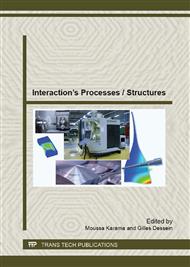[1]
T.Ozel, T.Altan, Process simulation using finite element method-prediction of cutting force, tool stresses and temperature in high speed flat end milling, International Journal of Machine Tools & Manufacture 40 (2000) 713–738.
DOI: 10.1016/s0890-6955(99)00080-2
Google Scholar
[2]
G.M. Pittala, M.Monno, A new approach to the prediction of temperature of the workpiece of face milling operations of ti-6al-4v, Applied Thermal Engineering 31 (2011) 173–180.
DOI: 10.1016/j.applthermaleng.2010.08.027
Google Scholar
[3]
B.Rao, C.R. Dandekar, Y.C. Shin, An experimental and numerical study on the face milling of ti-6al-4v alloy:tool performance and surface integrity, Journal of Material Processing Technology 211 (2011) 294–304.
DOI: 10.1016/j.jmatprotec.2010.10.002
Google Scholar
[4]
S.M. Afazow, S.M. Ratchev, J.Segal, Modelling and simulation of micro-milling cutting force, Journal of Material Processing Technology 210 (2010) 2154–2162.
DOI: 10.1016/j.jmatprotec.2010.07.033
Google Scholar
[5]
R. J. Saffar, M. Razfar, O.Zarei, E.Ghassemieh, Simulation of three-dimension cutting force and tool deflection in the end milling operation based on finite element method, Simulation Modelling Practice and Theory 16 (2008) 1677–1688.
DOI: 10.1016/j.simpat.2008.08.010
Google Scholar
[6]
H.Borouchaki, A.Cherouat, P.Laug, K.Saanouni, Adaptive remeshing for ductile fracture prediction in metal forming, C. R. Mecanique 330 (2002) 709–716.
DOI: 10.1016/s1631-0721(02)01519-x
Google Scholar
[7]
A.Cherouat, L.Moreau, H.Borouchaki, Advanced numerical simulation of metal forming processes using adaptive remeshing procedure, Material Science Forum 614 (2009) 27–33.
DOI: 10.4028/www.scientific.net/msf.614.27
Google Scholar
[8]
A.Cherouat, H.Borouchaki, K.Saanouni, P. Laug, Numerical methodology for metal forming processes using elastoplastic model with damage occurrence, J.Mater. Sci. Technol 22.
DOI: 10.4203/ccp.80.80
Google Scholar
[9]
H.Borouchaki, T.Grosges, D.Barchiesi, Improved 3d adaptive remeshing scheme applied in high electromagnetic field gradient computation, Finite Elements in Analysis and Design 46 (2010) 84–95.
DOI: 10.1016/j.finel.2009.06.026
Google Scholar
[10]
T.Grosges, H.Borouchaki, D.Barchiesi, Three dimensional adaptive remeshing scheme applied to the control of the spatial representation of complex feld pattern in electromagnetic, Applied Physics B 1 (2010) 883–889.
DOI: 10.1007/s00340-010-4155-y
Google Scholar
[11]
P. Perzyna, Fundamental problems in viscoplasticity, Advances in applied mechanics 9 (2) (1966) 244–368
Google Scholar
[12]
R.C. Batra, C.H. Kim, Effect of viscoplastic flow rules on the initiation and growth of shear bands at high strain rates, Journal of the Mechanics and Physics of Solids 38 (6) (1990) 859–874.
DOI: 10.1016/0022-5096(90)90043-4
Google Scholar
[13]
G.R. Johnson, W.H. Cook, Fracture characteristics of three metals subjected to various strains, strain rates, temperatures and pressure, Engineering Fracture Mechanics 21 (1985) 31-48.
DOI: 10.1016/0013-7944(85)90052-9
Google Scholar
[14]
J.L. Chaboche, G. Cailletaud, Integration methods for complex plastic constitutive equations, Comp. Meth. Appl. Mech. Eng. 133 (1996) 125-155.
DOI: 10.1016/0045-7825(95)00957-4
Google Scholar
[15]
J.C. Simo, R. Taylor, Consistent tangent operators for rate independent elastoplasticity, Comput. Methods Appl. Mech. Eng. 48 (1985) 101-118.
DOI: 10.1016/0045-7825(85)90070-2
Google Scholar
[16]
P.O. Bouchard, L. Bourgeon, An enhanced Lemaitre model formulation for materials processing damage computation, Int. J. Mater. Form. 4 (2011) 299–315.
DOI: 10.1007/s12289-010-0996-5
Google Scholar
[17]
ABAQUS, Theory Mannual, Version 6.10-2.
Google Scholar
[18]
A. Maillard, "Etude expérimentale et théorique du découpage", Thèse de Doctorat, Université de Technologie de Compiègne, Décembre, 1991.
Google Scholar
[19]
J-L. Bacaria, O. Dalverny, S. Caperaa, A 3D transient numericam model of milling, IMechE Journal of Engineering Manufacture, Part B, Vol 215(2001), pp.1-4.
DOI: 10.1243/0954405011518935
Google Scholar
[20]
Y.C. Zhang, T.Mabrouki, D.Nelias, Y.D. Gong, Fe-model for titanium alloy (Ti-6Al-4V) cutting based on the identification of limiting shear stress at tool-chip interface, Int J Mater Form., Vol 4(2011), pp.11-23.
DOI: 10.1007/s12289-010-0986-7
Google Scholar
[21]
Lesuer.DR, Experiment investigations of material models for Ti-6Al-4V titanium and 2024-T3 aluminum, Tech. rep. (2000).
Google Scholar
[22]
D.Umbrello, Finite elment simulation of conventional and high speed machining of Ti6Al4V alloy, Journal of Material Processing Technology 196 (2008) 79–87.
DOI: 10.1016/j.jmatprotec.2007.05.007
Google Scholar


